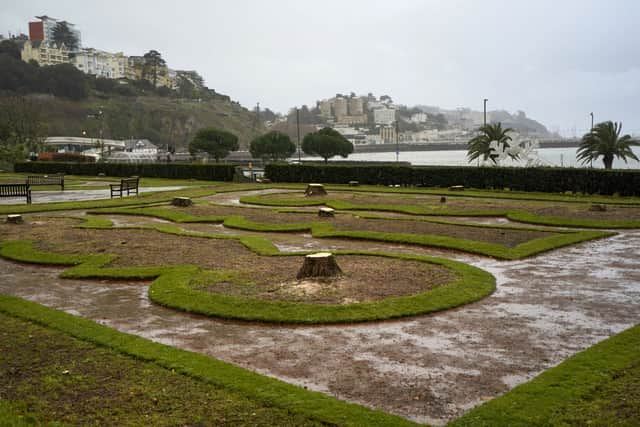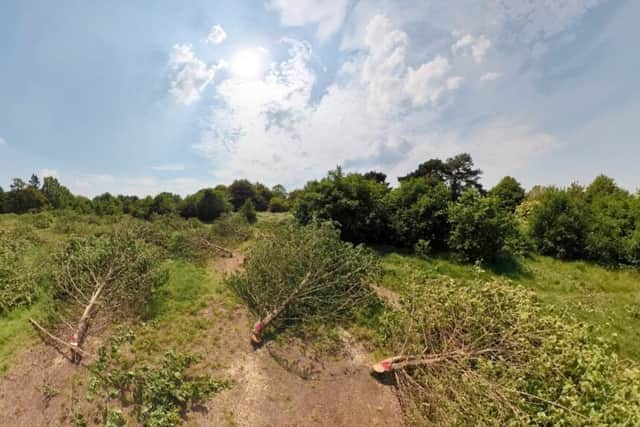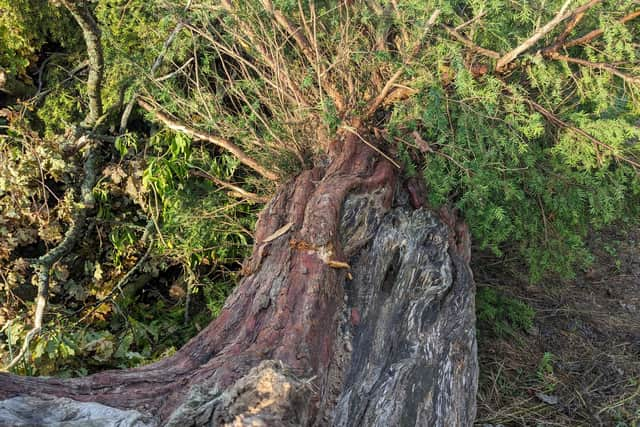Trees: The ancient giants and much-loved trees lost in 2023 - including the Sycamore Gap Tree
and live on Freeview channel 276
What was perhaps Britain's most photographed tree was illegally felled this year - triggering an outpouring of grief, and a newfound appreciate of the trees that share and shape our landscapes.
Sitting in a dramatic dip between two hills alongside Hadrian's Wall, the Sycamore Gap tree is believed to have been illegally felled overnight in late September. Once voted England's tree of the year, the roughly 300-year-old tree was featured in key scenes in Kevin Costner's 1991 film Robin Hood: Prince of Thieves. It was also believed to have caused some minor damage to the wall, a UNESCO World Heritage site, as it fell.
Advertisement
Hide AdAdvertisement
Hide AdNorthumbria Police's investigation into what happened that night is ongoing, but officers have said a 16-year-old and a man in his 60s who were originally arrested in connection to the felling would face no further action. Two men in their 30s remain on bail, and the force has pledged that those responsible will be brought to justice.
Amid the outpouring of grief on social media, some have taken up the Woodland Trust's call to make sure our ancient trees are better protected - by joining its Protect our Living Legends campaign. But the Sycamore Gap tree is far from the UK's only famed or significant tree to be felled - or to receive its death sentence - over the past year. Here are some of the other living legends we have lost, or could soon lose:


Darwin Oak
A 550-year-old oak which some say may have been scaled by Charles Darwin as a boy was handed its death warrant in 2023, after the Shropshire Council approved its felling to make way for a new bypass. The council says the Shrewsbury North West Relief Road, which could start being built as early as 2025, was the "next step in completing the ‘missing link’ in Shrewsbury’s road network".
But environmentalists say that for the road to go ahead, nine ancient trees - included the well-known Darwin Oak - would be felled. On top of that, they say it will lead to the destruction of many other trees, in one of the area's "last vestiges of beautiful countryside". The oak itself is an ancient giant with a massive 7-metre girth, named after Charles Darwin who frequently walked the area as a young man.
Advertisement
Hide AdAdvertisement
Hide AdCampaigners are still fighting to save the tree before it is too late - and a Change.org petition to move the development so that the Darwin Oak is spared destruction has gained nearly 95,000 signatures as of the end of 2023.


Torquay 'Palms'
The seaside resort town of Torquay, in Devon, has long had streets lined by so-called 'Torquay Palms'. The iconic and striking trees saw the town nicknamed the 'English Riviera', but locals were devastated to discover more than 40 of them, which had stood in the Italian Gardens since 1924, had been cut down earlier this month.
The palms are actually a species native to New Zealand, where they are known as cabbage trees or tī kōuka. They look similar to real palms, but can tolerate damper and milder climates than their tropical counterparts. But they are so closely associated with the town of Torquay that they are called Torquay Palms across the Northern Hemisphere, including in the US.
Locals were distraught when they saw the palms had disappeared from the seafront gardens. One person said they were "disgusted" and "devastated" at the felling, while another told SWNS the act was "pure vandalism".
Advertisement
Hide AdAdvertisement
Hide Ad"Trees are special for all sorts of reasons. Those palms are synonymous with Torbay," another commented, while someone who was born in Torquay recalled "many happy childhood days on the beach and on the green", and said the chopping down of the palm trees "saddens" them. "To see the palm trees have been CHOPPED down saddens me as that is what Torquay was all about. It was famous for its palms and visitors always enjoyed walking through the lovely gardens with the palms above them. It's going to look pretty bare now."
The trees were actually downed by Torbay Council, who said they had "significantly degraded" in the last 20 years. They were upgrading the Italian Gardens ahead of its 100th anniversary, a spokesperson said, and more would eventually be planted. However, locals still decried the lack of consultation from the council, and slammed it as "unfit for purpose" over the "dead of night" felling.


Cator Park Woodland Oaks
In June, more than 131 protected oaks - most of them self-seeded over the years - were illegally felled over a single weekend in a Southeast London beauty spot. The landowner and leaseholder have since been ordered by the local council to replant 131 oaks in the "much-loved mini woodland" beside Cator Park to take their place.
In a statement sent to NationalWorld, a Bromley Council spokesperson said their investigation into the felling was ongoing, and they would use all legal measures at their disposal. "In the days following the felling of the trees, which were included in a [tree preservation order], the council successfully sought an injunction to give further legal protection," they continued. "As part of our robust and methodological response to this desperately sad incident, we have now also notified the landowner of a legal requirement to re-plant oak trees on this much loved, mini woodland site.”
Advertisement
Hide AdAdvertisement
Hide AdCouncillor Angela Page said locals were “still quite rightly shocked and saddened at what took place on that fateful weekend". CPRE the Countryside Charity's London branch added that the Cator Woodland site had the same level of protection as the Green Belt. It had been used by the public for at least 20 years, they said, and was a haven for wildlife "including bats, woodpeckers, tawny owls, kingfishers, egrets, slow worms, a good range of butterflies and stag beetles".
But The Hopeson Group - the company which owns the land - told Sky News at the time it had leased out the land to be turned into sports facilities. Leaseholder Prince Choudary added his plan was to build sports fields for the community to use on the site, and that he had planned to replant some trees around their perimeters.


Battle of Hastings Yew
Days after the Sycamore Gap tree felling shocked the country, a yew tree so old it likely predated the Battle of Hastings was also downed. The fallen yew, which had stood beside a walkway near Battle - not far from Senlac Hill in East Sussex - was discovered by a tree surgeon who had once scattered his grandfather's ashes at its roots.
Arboriculturalist Paul Lawrence told the Argus that he believed the yew was likely over 1,000 years old - meaning it likely witnessed the historic battle which is believed to have taken place on the hill in 1066. He believed the tree had been purposely downed by a local landowner, but he claimed the local council had been uninterested. “I was in complete and utter disbelief," he said.
Advertisement
Hide AdAdvertisement
Hide Ad"This is an ancient marker of an old woodland, this keeps happening and no one seems to do anything... I would like this to raise awareness of how many of these ancient trees are being lost. They are being lost by the swing of a digger’s arm."
Colaton Raleigh Beech Trees
In the sleepy Devon village of Colaton Raleigh, residents were recently shocked by another case of much-loved trees being felled en masse - this time a stand of around 100 ancient beech trees. Locals called it an act of “environmental vandalism”, and told the Guardian the beeches had been in a special conservation area and site of special scientific interest, home to a vast array of wildlife.
Even worse, they were felled by the Forestry Commission - a government agency - without consulting the community or local council. While the agency told the paper it did not comment on individual cases, it said all decisions were taken in line with its standards.
Local tree warden Alan Pearce said local walkers who frequented the site were "absolutely horrified", or even in tears over the move. “It certainly ought to be a fairly wide consultation because it’s part of our heritage, grown-out hedges that go back hundreds of years. Once they’re gone you’re talking about 200 years to regrow," he said. "The stumps look nearly all of them perfectly sound and solid. I can’t see they can say they were diseased or dying. We’re meant to be planting trees, not felling them.”
Comment Guidelines
National World encourages reader discussion on our stories. User feedback, insights and back-and-forth exchanges add a rich layer of context to reporting. Please review our Community Guidelines before commenting.
